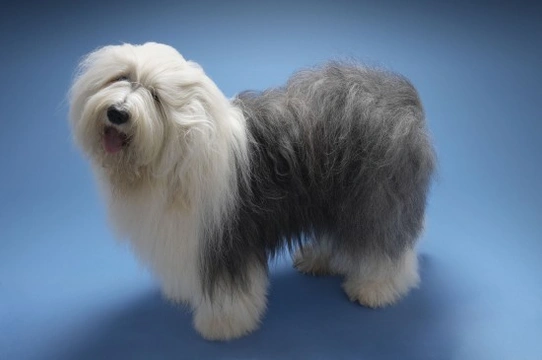Pets
Pets for studWanted petsBreedersAccessories & services
Knowledge hub
Support
Support & safety portal
Old English sheepdog hereditary health and health testing
The Old English sheepdog is one of the most instantly recognisable of all dog breeds, although you might know them better as “The Dulux dog,” due to their wide usage in adverts for the paint! They are a large breed that was developed within the UK as a working herding breed, and that has a very long, thick coat that is the breed’s most defining feature.
They can be seen in colours including grey, blue merle, grizzle, black or blue, and any colour may have white markings too. The coat is double layered and very thick, with a water resistant undercoat. Puppies of the breed are born black and white, and only develop their final coat colour when they reach maturity. Despite the sheer length and thickness of their coats, they do not tend to shed other than when being brushed, and need a high level of daily maintenance in order to keep their coats in good condition. The hair can grow very long and quickly obscure the eyes, which means that the hair over the eyes must be trimmed or tied back in order to allow the dog to see!
The Old English sheepdog can stand up to 24” tall at the withers, and weigh up to 46kg, with males being larger than females. They are heavy and well padded, and have a slow, rolling gait and general gentle and sedentary means of movement.
If you have fallen for the charms of the Old English sheepdog and aspire to owning a Dulux dog of your own, it is vital to do plenty of research into the breed before committing to a purchase. This includes finding out about the general health and longevity of the breed, which we will cover in more detail within this article.
Old English sheepdog average longevity
The average lifespan of the Old English sheepdog is 10-11 years based on survey data, but veterinary data collation indicates that the average lifespan of dogs of the breed may be rather shorter. While particularly large breeds of dogs do tend to have shorter lifespans than small breeds, the average lifespan of the Old English sheepdog is still classed to be rather shorter than the norm for equivalent breeds of a similar size.
Genetic diversity
The coefficient of inbreeding statistic for the Old English sheepdog is 9.7%, which is rather higher than the accepted ideal for pedigree breeds of 6.25% or lower. This indicates that the Old English sheepdog is subjected to a reasonable amount of inbreeding in order to keep the breed viable.
Conformation
While the shape and build of the Old English sheepdog itself does not pose any particular problems for the dog, the long, thick coat of the breed may cause some issues. Owners of dogs of the breed need to spend a significant amount of time grooming and taking care of the coat, as it has a tendency to become matted and tangled, which may impede normal movement or obscure the eyes.
Health testing
The British Veterinary Association and The Kennel Club recommend the following pre-breeding health tests, in order to improve the overall health of the breed and reduce the chances of hereditary health problems.
- Hip score testing, with the mean hip score across the breed being 11.3. Parent dogs should receive a hip score below this figure in order to be considered viable.
- Annual testing for hereditary cataracts, multi-ocular defects, and progressive retinal atrophy.
- DNA testing for cerebellar degeneration.
- DNA testing for multi-drug resistance.
- DNA testing for primary ciliary dyskinesia.
Other health issues
As well as the hereditary health issues mentioned above, the Old English sheepdog is also known to potentially suffer from certain other hereditary health issues, but not with a high enough occurrence rate that pre-breeding screening is widely offered. Potential Old English sheepdog buyers should make themselves aware of the possibility of the following health issues:
- Cerebellar abiotrophy, which leads to a progressive loss of coordination in affected dogs.
- Portosystemic shunt, a condition in which the blood’s circulatory system bypasses the liver, leading to the potential for a dangerous build-up of toxins within the blood stream.
- Immune mediated haemolytic anaemia, due to the destruction of red blood cells.
- Entropion of the eyelids, which causes them to invert towards the cornea.
- An autoimmune disorder called uveodermatological syndrome, which ultimately causes blindness and can be fatal.
- Osteochondrosis of the shoulder in males of the breed, which leads to pain, inflammation of the shoulder and lameness.
- Distichiasis, a condition in which the eyelashes grow an additional row of lashes, which may rub on the cornea and lead to pain and soreness.
- Urinary incontinence in spayed females if spaying is performed too early.
- Crystal and stone formation within the bladder.
- Various forms of cancer, particularly in old age.
- Cataracts of the eyes, particularly in old age. However, these are often operable in order to preserve the dog’s vision.
- Deafness.



